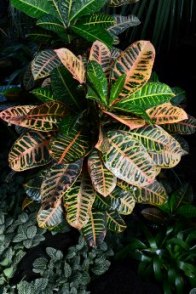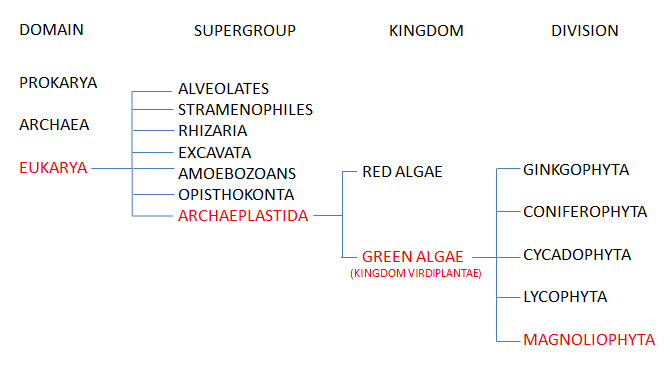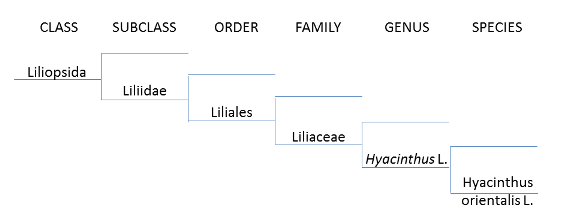
Classification
Domain: Eukarya
Supergroup: Archaeplastida
Kingdom: Plantae
Subkingdom: Tracheobionta
Superdivision: Spermatophyta
Division: Magnoliophyta
Class: Liliopsida
Subclass: Liliidae
Order: Liliales
Family: Liliaceae
Genus: Hyacinthus L.
Species: Hyacinthus orientalis L.
DOMAIN EUKARYA
What do Hyacinthus orientalis, a seahorse, and the split-gilled
fungus have in common? They're all eukaryotic! Eukarya is one of three domains for organisms (the other two being
Prokarya and Archaea). Eukarya is a classification derived from
the prokaryotes 1.7 billion years ago. Prokaryotes (from the
domain Prokarya) have no membrane-bound organelles, no true
nucleus, and are typically bacteria. However, membrane-bound
mitochondria and chloroplasts were formed quite differently.
According to the Endosymbiotic Theory, proposed by Dr. Lynn
Margulis, the mitochondria and the chloroplasts were both
originally independent prokaryotes before becoming engulfed by
the cell. Over time two organisms have become interdependent,
and how the mitochondria (and in plant cells, the chloroplasts)
are necessary for proper cell functioning. And, if you want to
learn more about other eukaryotes, such as
the great seahorse or
the split-gilled fungus, check out the
pages like this one done about them!
In case you're interested in learning more about the Endosymbiotic Theory (or the above description confused you), feel free to watch the following video by David Herbst, a science teacher who prefers to demonstrate science to students rather than telling them about it. His video outlines the theory surrounding the differences between prokaryotes and eukaryotes.
If the video isn't loading, here's the URL: http://www.youtube.com/watch?v=bBjD4A7R2xU.
SUPERGROUPS ARCHAEPLASTIDA
The supergroup Archaeplastida is one of the seven
protist supergroups. Members of Archaeplastida are
photosynthetic and can be multicellular or unicellular, and many
exhibit an alternation of generations (from a single DNA type
haploid to two DNA types diploid). Archaeplastida includes two
broad groups: the red algae and green algae. Green algae - due
to its cellulose cell walls, enzymes in peroxisomes, sperm
structure, cell division, and genetic code - is said to be
linked to land plants.
KINGDOM PLANTAE
Kingdom Plantae, or Virdiplantae, is said to have
been derived from the green algae protists (which have varied in
their classification, hence the alternate name "Kingdom
Virdiplantae"). Members of the kingdom are plants, which serve
as primary producers and give off oxygen as a biproduct of
photosynthesis (the process by which plants acquire food). Some
examples of plantae include the
American Mountain Ash and
Witchhazel.
CO2 + H2O à C6H12O6 + O2
The chemical formula of photosynthesis: one mole (a given quantity) of carbon dioxide (CO2) reacted with one mole of water (H2O) makes one mole of dextrose (a sugar used for energy, C6H12O6) and one mole of oxygen gas (O2), with the help/input of sunlight.
All three images are of organisms of the Kingdom Plantae (or Virdiplantae). They are also all images taken by yours truly, Libby Jachimiec.
SUBKINGDOM TRACHEOBIONTA
The subkingdom Tracheobionta refers to vascular
plants.
SUPERDIVISION SPERMATOPHYTA
The superdivision Spermatophyta refers to
seed-producing plants.
DIVISION MAGNOLIOPHYTA
The division Magnoliophyta refers to flowering
plants, also known as "Angiosperm." Plants under this division
are also known to have true roots, stems, and leaves.
Above graphic created by me, Libby Jachimiec.
CLASS LILIOPSIDA
The class Liliopsida is also known as "monocots," or
"monocotyledons," meaning that seedlings produce only one leaf.
Other characteristics of monocots include parallel leaf
venation, petals in multiples of three, scattered vascular
tissue inside the stem, a fibrous root system, and a pollen
grain with a single opening. To see some other examples of
monocots, check out the webpages about
ginger or
tumeric.
While one might think that all flowering plants are similar,
there are significant distinctions between them. The class
Liliopsida, also known as the monocots, is paralleled by the
Magnoliopsida, or the dicots. To see some neat examples of
dicots, check out the pages for the
bloodroot (the webpage done by my friend Ivy),
opium poppy,
purple passion flower,
dragonfruit or
pomegranate.
SUBCLASS LILIIDAE
The subclass Liliidae contains nearly 8000 species,
approximately half of which belong to the familiy Liliaceae. The
organisms belonging to Liliidae typically are pollinated by
insects and have well-developed nectaries.
 ORDER LILIALES
ORDER LILIALES
The order Liliales was once
considered the largest group of monocots, but due to molecular
and morphological research is now a group containing only 1200
species. Organisms belonging to Liliales grow from bulbs or
corms, two forms that can store food during dry seasons or
winter months.
FAMILY LILIACEAE
The family Liiliaceae includes approximately 4000
living species. As their flowers are known for being
particularly showy, they are often used in gardening, though
some are also used for food or for their medicinal properties.
Another organism belonging to the Liliaceae family is the Autumn
crocus, which you can learn more about
here (coincidentally, the page for the autumn crocus was
completed by my good friend Hannah, so go check it out!).
GENUS HYACINTHUS
L.
The genus Hyacinthus L. refers to three
species of plants: Hyacinthus litwinovii, Hyacinthus
transcaspicus, and Hyacinthus orientalis. The
three flowers differ in their characteristics, with
Hyacinthis litwinovii and Hyacinthus transcaspicus
having the most in common.
SPECIES HYACINTHUS ORIENTALIS
L.
Well! There's a lot to say about
Hyacinthus orientalis L.; fortunately for you, there's an
entire webpage dedicated to information about it. And
fortunately for you (again), you're already on that webpage.
That's convenient, right?
To keep learning about Hyacinthus orientalis L., continue on to the habitat page.
Return to homepage.






